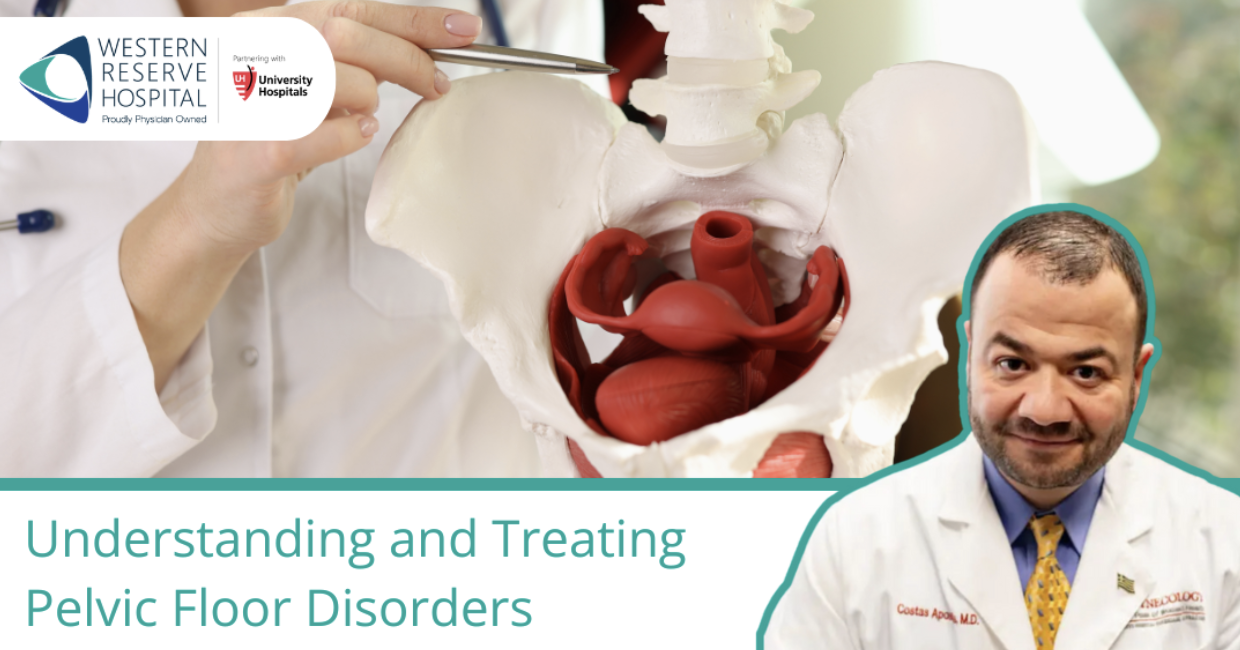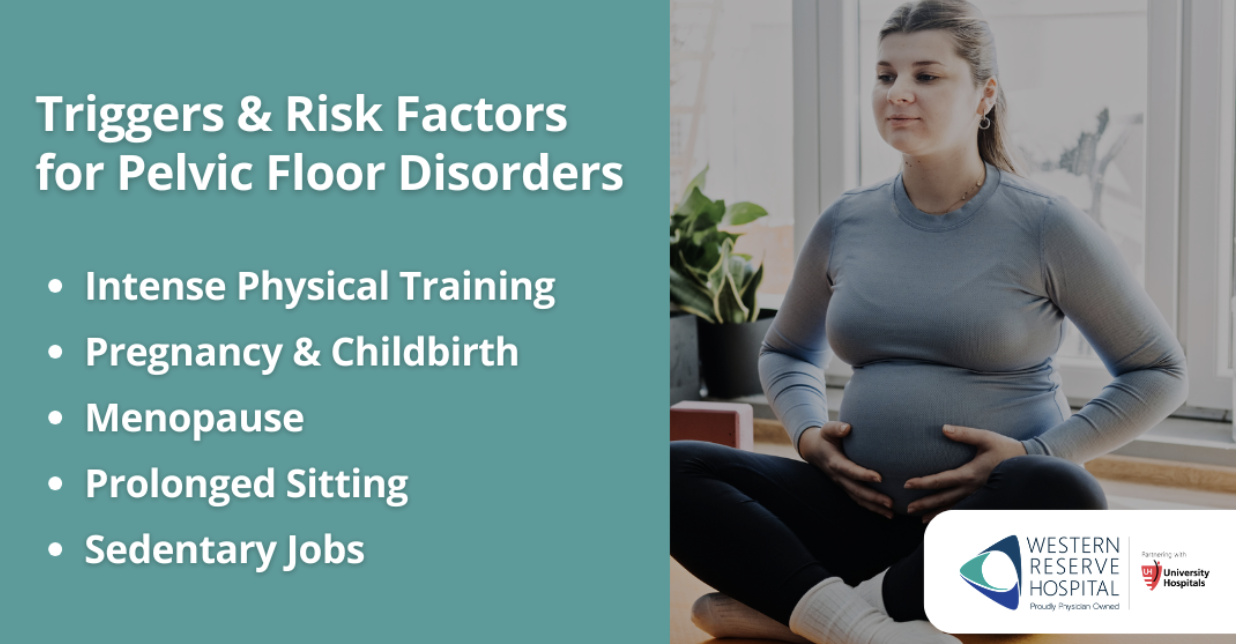
People who struggle with pelvic floor issues feel like they're dealing with something no one else understands. The truth is that pelvic floor disorders affect a large number of women, and yet it’s something we don’t often talk about.
We’re here to change that.
We gathered expert insights about pelvic floor disorders from Dr. Costas Apostolis, our urogynecologist at Western Reserve Hospital.
We’ll draw on his expertise to explain what pelvic floor disorders are, what causes them, and how they can be treated and prevented.
What Are Pelvic Floor Disorders?
Pelvic floor disorders are a group of conditions affecting the muscles of the pelvic region.
According to Dr. Apostolis, these disorders occur when the muscles of the pelvis — which support the bladder, uterus, and rectum — become weakened or strained.
Pelvic floor disorders can lead to:
- A persistent sense of pressure
- Discomfort in the lower abdomen or pelvis
- Leg misalignment
These issues affect daily life, limiting physical activity and impacting intimate relationships.
Women from all backgrounds, ages, and ethnicities experience pelvic floor disorders, yet they are often misunderstood or misdiagnosed.
Symptoms like pain, urinary issues, or discomfort during intercourse are sometimes wrongly attributed to other conditions, such as urinary tract infections. This leads to frustration and delays in getting the right treatment.
Most Common Types of Pelvic Floor Disorders
The most common types of pelvic floor disorders that Dr. Apostolis encounters in his practice are:
- Pelvic floor dysfunction. This occurs when the pelvic muscles remain excessively contracted. It’s similar to how a kink in the neck causes discomfort. Patients may initially think they have a urinary tract infection due to the burning and urgency they feel, but testing shows no infection.
- Pelvic organ prolapse (POP). Dr. Apostolis describes this as a hernia. It’s when pelvic organs like the urinary bladder move out of their place. POP feels like something is “falling out” of the vagina and creates a sensation of heaviness or pressure.
- Urinary incontinence. This is the involuntary leakage of urine due to weak pelvic muscles. It is often caused by strain from childbirth or aging.
- Painful intercourse (dyspareunia). This is when intimacy becomes painful due to pelvic floor tension or organ prolapse. Dr. Apostolis notes that it feels as if a tampon is in place. But what’s actually causing the sensation is a dropped pelvic organ, like the bladder or uterus entering the vaginal canal.
Early Signs and Symptoms of Pelvic Floor Disorders To Watch For
Dr. Apostolis explains that one of the commonest and earliest signs is vaginal pressure or a bulging sensation. Many women describe it as feeling like there is a tampon in place, even if they don’t use one.
Other signs and symptoms include:
- Urgency, burning, or pain during urination
- Hip or low back pain
- Pain with sexual activity, particularly during deep penetration
- Leakage of urine when laughing, sneezing, or moving
“Thirty to forty percent of women who have incontinence of urine will also have some form of pelvic organ prolapse,” explains Dr. Apostolis.
Real-Life Triggers and Risk Factors for Pelvic Floor Disorders

Pelvic floor disorders can be triggered or worsened by several factors, many of which stem from our daily activities or life stages. Here are some common risk factors:
- Intense physical training. Dr. Apostolis explains that intense physical training, such as CrossFit, High-Intensity Interval Training, or heavy lifting, puts significant strain on the pelvic floor muscles. These activities involve explosive movements and heavy loads or high-impact exercises. The repeated pressure, especially if proper technique isn’t used or recovery time is too short, can lead to pelvic floor dysfunction.
- Pregnancy and childbirth. Pregnancy places a significant load on the pelvic floor muscles, with added weight ranging from 20 to 40 pounds. This extra weight, combined with the physical changes during pregnancy and the strain of childbirth, stretches and weakens the pelvic muscles. The trauma of labor, including the pressure from pushing and the potential for tears, can also contribute to pelvic organ prolapse and urinary incontinence.
- Menopause. As estrogen levels decrease after menopause, the tissues and muscles of the pelvic floor become weaker and less elastic.
- Prolonged sitting and sedentary jobs. Sitting for long periods increases pressure on the pelvic area and lower back, which causes the muscles to become stiff and fatigued.
The Role of Genetics in Pelvic Floor Disorders
Pelvic organ prolapse risk may be genetic, as Dr. Apostolis notes that the quality and strength of pelvic tissues can be inherited.
If you have a family history of pelvic floor issues, you may be genetically more likely to develop these conditions regardless of other lifestyle factors.
Dr. Apostolis recalls seeing two sisters — one a nun and the other a mother of four. The nun, who had never given birth, experienced a severe pelvic organ prolapse. Her sister, who had delivered four children vaginally, had no symptoms of prolapse.
The nun’s condition was a direct result of genetic factors that affected her tissue strength and fascia. Her sister, despite having multiple vaginal deliveries, had stronger connective tissue that protected her from pelvic floor disease.
Despite childbirth being a well-known risk factor, this case shows that genetics play a significant role in the development of pelvic floor dysfunction.
How Are Pelvic Floor Disorders Diagnosed?
Diagnosing pelvic floor disorders involves a detailed symptom history and a physical exam to evaluate the pelvic muscles and organs.
Dr. Apostolis emphasizes that the physical exam is crucial in determining whether conditions like pelvic organ prolapse are present and, if so, which organs are affected.
Through the exam, urogynecologists can identify if the bladder, rectum, or uterus is dropping into the vaginal canal.
During the exam, your provider will also assess the pelvic floor muscles for any signs of tenderness or muscle tightness, which can indicate pelvic floor dysfunction.
In some cases, further tests may be necessary to assess issues like urinary incontinence or more complex prolapse.
Why Kegels Don’t Always Help With Pelvic Floor Dysfunction
Kegel exercises are often recommended for pelvic floor health. But they are not always the miracle solution many people expect.
Dr. Apostolis says that many patients come to the hospital expressing their frustration, saying, “I’ve been doing Kegels for 20 years, and nothing changed.”
That’s because Kegels are not designed to reverse prolapse or address the structural issues that cause urinary incontinence.
They are excellent for strengthening the pelvic floor muscles to help with urgency and preventing leakage when you feel like you can’t make it to the bathroom in time.
However, they won’t lift dropped organs back into place or restore the muscle tone needed to address prolapse.
Kegels can be done discreetly and are easy to incorporate into your day. But they may need to be combined with other therapies to fully restore pelvic health.
The Power of Pelvic Floor Therapy
Pelvic floor therapy provides hands-on, highly individualized care in the treatment of pelvic floor disorders. As per Dr. Apostolis, it is just as important as surgery in treating pelvic floor dysfunction.
For many women, especially those with muscular discomfort, the therapy involves internal physical therapy performed by trained female specialists. These therapists work within the vaginal canal to release tight muscles and retrain the pelvic floor.
Each treatment plan is tailored to the needs of the patient, based on their symptoms and condition. The therapy targets the specific muscles that need attention and focuses on relaxing and retraining them for optimal function.
Dr. Apostolis stresses how essential pelvic floor physical therapy is in his practice. Without it, he says, many aspects of pelvic floor dysfunction cannot be effectively treated.
Lifestyle and Prevention Tips for Pelvic Floor Disorders
Preventative practices play an important role in maintaining pelvic health. Here are some tips from Dr. Apostolis:
- Relaxation and rest. Incorporate relaxation techniques to reduce stress and allow the pelvic muscles to recover.
- Stretching and mindful movement. Engage in gentle stretching, yoga, or other mindful exercises to improve flexibility and reduce muscle tension.
- Avoid high-impact exercises during flare-ups. During periods of discomfort or flare-ups, avoid running or jumping. These place additional strain on the pelvic floor. Opt for low-impact exercises such as walking or swimming instead.
- Pelvic floor physical therapy. Seeing a specialist in pelvic floor physical therapy is one of the best ways to strengthen and care for the pelvic floor muscles. They can design a personalized exercise plan based on your specific needs and condition.
Breaking the Stigma Around Pelvic Floor Dysfunction — You’re Not Alone
Pelvic floor issues are more common than you realize — one in three women experience some form of pelvic floor disorder. Yet, many women suffer in silence because they feel embarrassed or uncomfortable discussing their issues.
Dr. Apostolis emphasizes that pelvic floor disorders are a normal part of life, especially as we age. “This is a normal part of who they are; it’s not something that they caused to their bodies,” he explains.
Most importantly, you are not alone. If you walk into a crowded place, know that one in three women you pass may be experiencing the same struggles.
Reach out to your primary care doctor, OB-GYN, or urogynecologist, and don’t let embarrassment hold you back from living a more comfortable, confident life.
When To Seek Help for Pelvic Floor Disorders
Dr. Apostolis says, “If you come see someone like me, the first question I’ll ask is: 'How much does it affect you?'”
If pelvic floor issues are causing you discomfort or embarrassment, or preventing you from enjoying your everyday activities, it’s a sign that professional help is needed.
It’s not just about the symptoms but how much they impact your life. Examples of significant impact include:
- Avoiding social gatherings due to frequent bathroom needs
- No longer participating in previously enjoyed physical activities like running or dancing
- Experiencing intimate relationship strain due to sexual dysfunction
- Planning errands based on how close a bathroom is
- Wearing protective undergarments daily
- Feeling constant anxiety about potential leakage in public
When symptoms begin dictating your choices and limiting your freedom, professional help is needed.
Hope, Healing, and Next Steps for Pelvic Floor Disorders
Pelvic floor disorders are far more common than we realize, but they are by no means something you have to quietly endure.
There’s a wealth of help available, ranging from pelvic floor physical therapy to simple lifestyle changes that can improve your quality of life.
If you're experiencing symptoms like incontinence, pelvic pain, or a sense of pressure, don’t wait for things to “get better on their own.”
It’s always a good idea to consult with your OB-GYN or a urogynecologist like Dr. Apostolis at Western Reserve Hospital. Remember, the earlier you act, the better the outcome. Book your appointment today.
FAQs
What Causes Pelvic Floor Dysfunction?
Pelvic floor dysfunction can be caused by high-impact workouts, childbirth, aging, hormonal shifts, or poor posture.
Is Surgery Always Required for Pelvic Floor Disorders?
Not at all. Many cases of pelvic floor disorders improve dramatically with pelvic floor therapy alone.
Can Young Women Get Pelvic Floor Disorders?
Yes, many patients who experience pelvic floor dysfunction are in their 30s and 40s, especially athletes.
